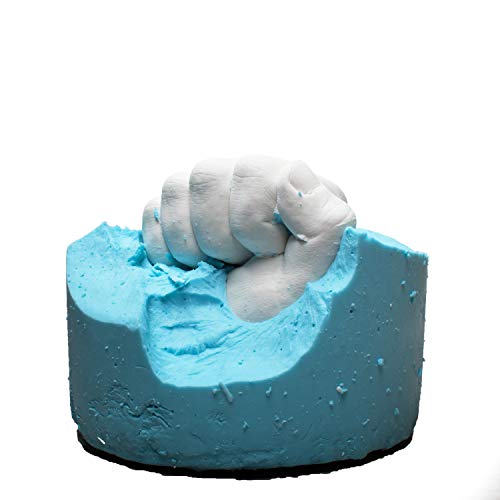Alginate Hand Casting
Safety First!
Before using our products, please read the SDS and TDS, located under the product description on our website. One of the amazing features about Alginate is that it is skin safe. When measuring, mixing or pouring plaster or gypsum please wear a mask and gloves. Do not put plaster or gypsum directly on skin, as it may cause injury. Speak to our friendly staff in-store, or email [email protected] for any further information about body casting.
What size hand are you moulding?
Before you purchase Alginate for hand casting, it is important to know the size of the hand you wish to duplicate. As an example, a larger adult hand will require both more product, and a larger receptacle to contain the mould than would be required for child’s hand. The second decision to make will be how far up the arm you would like to represent in your mould. Including the forearm in your mould will require a longer moulding receptacle, and more alginate.
Choosing the Right Alginate
For a baby or small child’s hand, you may consider using a faster setting Alginate, such as Dental Alginate, as this will make the process quicker for the model. For an adult hand it is preferable to choose a slower setting alginate, as there will be more product to mix.
Preparing the Mould
We suggest using a piece of PVC pipe for this project, in the size and length suitable to the hand/forearm you are moulding. Prepare the pipe by cutting down one side of it, and then re-taping this opening together securely. This will make it easier to remove the mould structure once the alginate has set. Thoroughly tape off one end of the open pipe, making sure it is completely closed off. This will ensure that no alginate leaks from the mould structure.
Measuring and Mixing
Depending on which alginate you choose for your project, the work and cure times may vary greatly. Please refer to the ratio instructions on the packaging before beginning your hand casting project. An approximate volume measurement will help you assess how much Alginate is right for your project. Use 600ml or 1L measuring cups to measure your Alginate and water. A clean 4 litre ice cream container or small buckets are a suitable choice to mix Alginate into.
Mix the Alginate and water quickly. Use a spatula of suitable length to ensure the powder and water are combined adequately.
Pouring the mould
Once the product is mixed, you are ready to pour it into the sealed pipe. Do not overfill the pipe, as once the hand is plunged into the mixture, it will rise.
Place the hand into the mould, dipping straight to the bottom and then rising to the centre of the mould, not touching the sides or bottom. For an adult hand cast using a slower Alginate, you can lift out the hand quickly once dipping it in to make sure the fingers are adequately coated, before returning it to the alginate, not touching the sides or bottom of the pipe.
Once in the position of your choice, the hand should be kept as still as possible whilst the Alginate is setting, to ensure the greatest amount of detail is transferred to the mould surface.
Curing and Removing the Hand from the Mould
Once the Alginate has set as per the packaging instructions/ TDS, the mould will be flexible enough to gently wriggle the hand free from the mould. Do this carefully so the fresh mould is not damaged. Any residue on your model’s hand will be easily washed off with soap and water. Do not remove the set alginate from the pipe! This will keep structure to the mould when you are casting into it. You are now ready to cast into the mould!
Casting Into the Mould
Alginate is an organic material; therefore, it will shrink and deteriorate quickly after the mould is created. Planning ahead and having your casting material at hand is very important. Your mould should ideally be cast into as soon as possible after moulding. An Alginate mould is always a single use mould, as the mould is destroyed when removing the first cast.
You can cast into your Alginate mould with plaster or gypsum. Resin is not a suitable material to cast into Alginate, as the moisture in the mould will prevent the resin from curing.
Before casting into your mould, rinse it out under lukewarm water, as this will remove any dirt or oils from the hand that may affect the cast surface.
Measuring, Mixing and Pouring
Depending on your choice of casting product, measuring ratios may vary. Please refer to the packaging and product TDS for this information.
You can re-use your mixing buckets for your casting material, just ensure they are thoroughly clean and dry. Do not clean your buckets into a drain as the plaster may clog your pipes.
Tip! Plaster always gets added to water, not the other way around.
Pour the plaster/gypsum into the mould/ Pour slowly and carefully so that all parts of the mould are filled.
Demoulding the Hand Cast
Once the casting material has set, you can begin the demoulding process. Remove the tape from the side and bottom of the pipe, be careful not to drop your mould, as plaster and gypsum will break if dropped.
Gently start to cut away at your alginate with a scalpel, being very careful not to touch the cast surface with the blade as it will mark the cast surface.
Once all the alginate is removed, your finished cast will be revealed!
What’s next?
Plaster and Gypsum can be porous materials, that attract dirt easily, so you may want to finish your cast with some Metal Paint or Patina, to create a metal cast effect.


